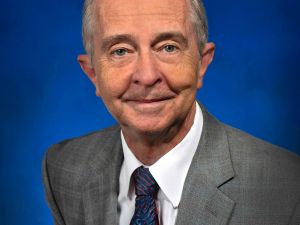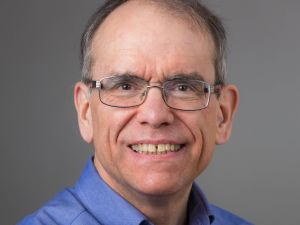A Full-Circle Career: Professor of Physics Glenn Edwards Retires After 25 Years at Duke

Career trajectories can take many shapes: a steep upward slope, a meandering wave, a steady sequence of steps (let’s not even mention the possibility of a downfall). Glenn Edwards’ career was shaped like a perfect full circle.
The Emeritus Professor of Physics joined Duke in 1999 as the director of the Free Electron Laser Laboratory, a facility housing an accelerator-based light source — an apparatus where electrically charged particles are propelled at very high speeds to generate a tunable laser beam. He retired from Duke this summer, after seeing one of his main projects reach a development stage that seemed unfathomable a couple of decades ago. The path separating these two research data points was anything but linear, though.
As a college student, Edwards’ first inclination wasn’t exactly in line with the rest of his career. “I was attracted to philosophy, and that led to a revolt from my family, so I thought I'd do something practical, like computer science, but I hated it,” he said. “And then I read ‘The Double Helix,’ and thought, ‘Aha, that's what I want to do. I want to apply the tools of physics to biological problems.’”
His first faculty position was at Vanderbilt University, where he tuned a type of free electron laser (FEL) — a Mark III — so that it produced pulses of infrared light that cut into brains without collateral damage. His research team achieved the degree of accuracy needed for such an incredibly delicate task, with one hiccup: the beam emanated from an apparatus as large as a tractor trailer truck.
Dragging such an apparatus inside of an operating room was, of course, impossible. Instead, the Mark-III FEL was housed in an entire sub-basement and the laser beam would travel up three floors through a periscope-like series of tubes, all the way to a maneuverable pen-like instrument hanging from the OR’s ceiling. The Mark III’s medical precision couldn’t justify its impracticality.
Edwards said that all the while he was trying to understand how to replicate such precise laser incisions in a more compact laser. “And during my first years at Duke, we figured it out.” But this compact laser, too, had a hiccup: not enough power for surgical applications.
“We needed a factor of 100 more average power,” said Edwards. “I eventually reached the conclusion that the required technology didn’t exist yet, so I stopped working on that research problem and waited for the technological revolution.”
Edwards stepped down from his post as director of the Free Electron Laser Laboratory in 2008. “On the laboratory management side of my career, it just seemed that I wasn't doing anything novel anymore. It had become rather routine.”
In the meantime, he had started a collaboration with Professor of Biology Dan Kiehart and Professor of Mathematics Stephanos Venakides studying pattern formation in developmental biology. Pattern formation is the process through which seemingly identical cells in a fruit fly differentiate into distinct groups with complex forms and functions that make up the fly’s body plan. Lasers allowed for developmental biology experiments requiring ultra-precise incisions in tiny fruit flies, and Edwards’ biophysics background helped generate quantitative models to explain the patterns through which cells re-organized themselves as the fruit fly embryo developed.
“It was joyful to start a new research direction,” he said. “Initially I knew very little about the field, but it struck me that this was a research problem where my skill set could help.”
Unbeknownst to Edwards at the time, the technological revolution he’d been waiting for was underway on the other side of the world. In 2019, following an invitation by two of his ex-postdocs, Heng Lu and Feng Lu, he traveled to China to give a series of lectures and was introduced to one of Heng Lu’s senior colleagues, an expert in laser development.
“His lab was stunning,” said Edwards. Intrigued, he described in detail the performance requirements for the laser he had tried to build all those years ago, and asked: “Do you think you can build this laser?”
The interpreter translated. “It was a long translation, and then a one-word answer: ‘yes.’” A collaboration had begun.
Edwards unresolved challenge in the early 2000s had been to increase the compact laser’s power by a factor of 100. Today, the laser built in collaboration with Shen and her research group in Beijing has increased the average power by more than a factor of 1000, and fits in a large briefcase. Next steps? Tweaking the pulse structure of the Beijing technology to achieve laser incisions with minimal or no collateral damage.
Edwards wants to see the project proceed to medical applications, and is punctuating his early retirement with regular visits to China. “I will collaborate with Yu Shen and her research group until I feel that they don't need my help anymore,” he said. “Then I'll just throw it over the fence and go play with my grandchildren.”
Throughout his career at Duke, Edwards was also a passionate teacher. “You're not doing novel research, but you're bringing students along, and for them the concepts are novel,” he said. “It's like Dorian Gray, right? I got older and older, but the students were always 18 to 22, and really talented. ‘A’-students will do well no matter what, just don't do anything to misguide them. What I really found rewarding was working closely with a student and having a sense that I helped them get a better grade.”
A highlight of his career? “There were three or four moments in my career where I got to tell the world how nature works. That is incredibly rewarding.
“Then the other one was when I got season basketball tickets.”




